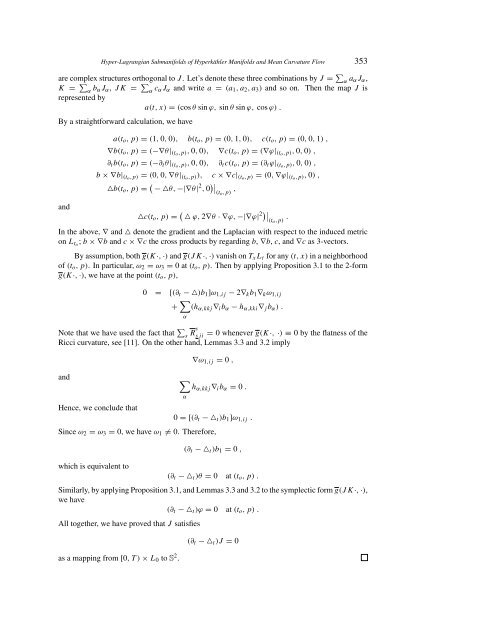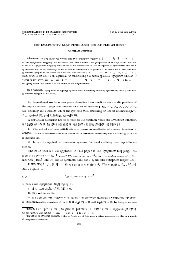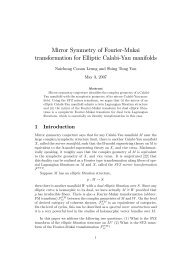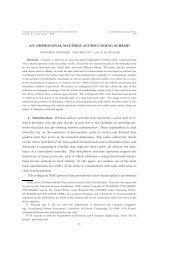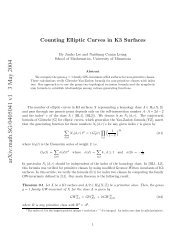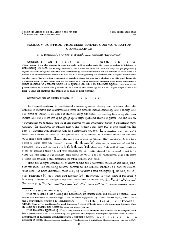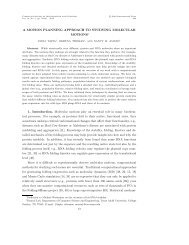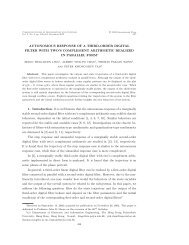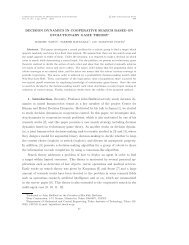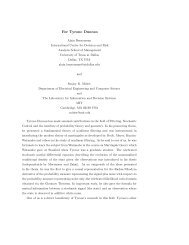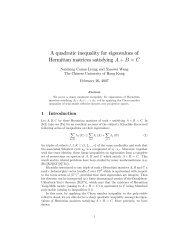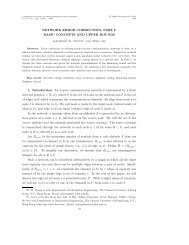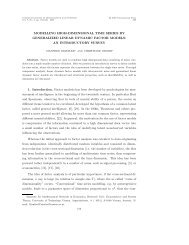Hyper-Lagrangian Submanifolds of Hyperkähler Manifolds and ...
Hyper-Lagrangian Submanifolds of Hyperkähler Manifolds and ...
Hyper-Lagrangian Submanifolds of Hyperkähler Manifolds and ...
You also want an ePaper? Increase the reach of your titles
YUMPU automatically turns print PDFs into web optimized ePapers that Google loves.
<strong>Hyper</strong>-<strong>Lagrangian</strong> <strong>Submanifolds</strong> <strong>of</strong> <strong>Hyper</strong>kähler <strong>Manifolds</strong> <strong>and</strong> Mean Curvature Flow 353<br />
are complex structures orthogonal to J . Let’s denote these three combinations by J = ∑ α a αJ α ,<br />
K = ∑ α b αJ α , JK = ∑ α c αJ α <strong>and</strong> write a = (a 1 ,a 2 ,a 3 ) <strong>and</strong> so on. Then the map J is<br />
represented by<br />
a(t,x) = (cos θ sin ϕ, sin θ sin ϕ, cos ϕ) .<br />
By a straightforward calculation, we have<br />
<strong>and</strong><br />
a(t o ,p)= (1, 0, 0), b(t o ,p)= (0, 1, 0), c(t o ,p)= (0, 0, 1) ,<br />
∇b(t o ,p)= (−∇θ| (to ,p), 0, 0), ∇c(t o ,p)= (∇ϕ| (to ,p), 0, 0) ,<br />
∂ t b(t o ,p)= (−∂ t θ| (to ,p), 0, 0), ∂ t c(t o ,p)= (∂ t ϕ| (to ,p), 0, 0) ,<br />
b ×∇b| (to ,p) = (0, 0, ∇θ| (to ,p)), c ×∇c| (to ,p) = (0, ∇ϕ| (to ,p), 0) ,<br />
△b(t o ,p)= ( −△θ,−|∇θ| 2 , 0 )∣ ∣<br />
(to ,p) ,<br />
△c(t o ,p)= ( △ ϕ,2∇θ ·∇ϕ,−|∇ϕ| 2)∣ ∣<br />
(to ,p) .<br />
In the above, ∇ <strong>and</strong> △ denote the gradient <strong>and</strong> the Laplacian with respect to the induced metric<br />
on L to ; b ×∇b <strong>and</strong> c ×∇c the cross products by regarding b, ∇b, c, <strong>and</strong> ∇c as 3-vectors.<br />
By assumption, both g(K·, ·) <strong>and</strong> g(JK·, ·) vanish on T x L t for any (t, x) in a neighborhood<br />
<strong>of</strong> (t o ,p). In particular, ω 2 = ω 3 = 0at(t o ,p). Then by applying Proposition 3.1 to the 2-form<br />
g(K·, ·), we have at the point (t o ,p),<br />
0 = [(∂ t −△)b 1 ]ω 1,ij − 2∇ k b 1 ∇ k ω 1,ij<br />
+ ∑ α<br />
(h α,kkj ∇ i b α − h α,kki ∇ j b α ).<br />
Note that we have used the fact that ∑ s Rs sji = 0 whenever g(K·, ·) ≡ 0 by the flatness <strong>of</strong> the<br />
Ricci curvature, see [11]. On the other h<strong>and</strong>, Lemmas 3.3 <strong>and</strong> 3.2 imply<br />
<strong>and</strong><br />
∇ω 1,ij = 0 ,<br />
∑<br />
h α,kkj ∇ i b α = 0 .<br />
Hence, we conclude that<br />
0 =[(∂ t −△ t )b 1 ]ω 1,ij .<br />
Since ω 2 = ω 3 = 0, we have ω 1 ̸= 0. Therefore,<br />
α<br />
(∂ t −△ t )b 1 = 0 ,<br />
which is equivalent to<br />
(∂ t −△ t )θ = 0 at(t o ,p).<br />
Similarly, by applying Proposition 3.1, <strong>and</strong> Lemmas 3.3 <strong>and</strong> 3.2 to the symplectic form g(JK·, ·),<br />
we have<br />
(∂ t −△ t )ϕ = 0 at(t o ,p).<br />
All together, we have proved that J satisfies<br />
as a mapping from [0,T)× L 0 to S 2 .<br />
(∂ t −△ t )J = 0


